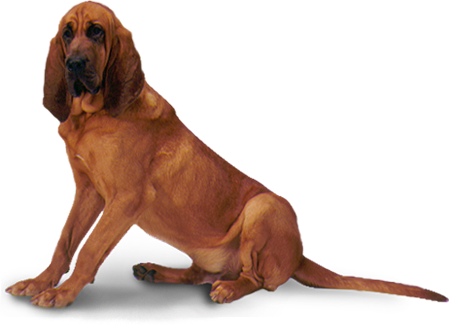Type the name of the breed you're looking for below
[wpdreams_ajaxsearchlite] Don't see the breed your're looking for? Click here and let us know!
Breed Characteristics
1 paw - breed exhibits the least amount of this characteristic
5 paws - breed exhibits most amount of this characteristic
Bloodhound
| Other Names | St. Hubert Hound, Chien de Saint-Hubert, Flemish Hound |
| Nicknames | Sleuth hound |
| Country of Origin | Belgium,France,England or Scotland |
| Weight | Males: 90 - 110 lbs. (41 – 50 kg) Females: 80 - 100 lbs. (36 – 45 kg) |
| Height (at withers) | Males: 25 - 27 in. (63 – 69 cm) Females: 23 - 25 in. (58 – 63 cm) |
| Coat | The coat is wrinkled, short and fairly hard in texture, with softer hair on the ears and skull. |
| Colour | Colours include black & tan, liver & tan, red & tawny and red. Sometimes there is a small amount of white on the chest, feet and tip of the stern. |
| Litter Size | 6-10 puppies, Average is 8 |
| Life Span | 8-12 years. |
| Origin & History | Bloodhounds were one of the first dogs to be carefully bred according to a standard. Bloodhounds are probably one of the oldest breeds of dogs to originate in Europe. The origin of the Bloodhound dates back at least as early as the Seventh Century. It was at that time that Saint Hubert, a famous hunter known for his highly skilled deer-hunting hounds, converted to Christianity and abandoned the hunt for more ecclesiastical pursuits. Saint Hubert eventually became the patron saint of hounds and the hunt. It is unclear if the actual hounds used by Saint Hubert are the direct ancestors of the Bloodhound, but it is clear that the dogs bred by the monks at the monastery named after him were. The Abbey of Saint Hubert is located in Mouzon in the Ardennes region of France. The Abbey became famous for breeding dogs in the Middle Ages and throughout the Renaissance. The monks at Saint Hubert put a careful focus on their hound breeding that would be very rare until the Nineteenth Century. Their hounds were “blooded,” or “of pure blood.” These hunting dogs eventually became known as Saint Hubert Hounds. It is unclear exactly when the Saint Hubert Hound came into existence, but it most likely occurred sometime between 750 and 900, well over a thousand years ago. It is unclear exactly what dogs the monks of the Abbey of Saint Hubert used to create their new breed. Some tales say that the dogs are the direct descendant’s of Saint Hubert’s hounds, although this is impossible to verify, and is probably unlikely. Perhaps the most common tale is that crusaders returning from the Holy Land brought back Arabic and Turkish hounds with them. However, this is unlikely as apparently no historic records exist of such a practice happening. Additionally, there are no Middle Eastern dog breeds modern or historical which closely resemble depictions of the Saint Hubert Hound. This theory is made even less likely by the fact that the Abbey of Saint Hubert began breeding their dogs sometime between 750 and 900, and the First Crusade did not begin until 1096. It is more likely that the Saint Hubert Hound was developed by carefully breeding local French hounds, with an occasional foreign dog with desirable traits added to the bloodlines. The carefully bred hunting hounds became very desirable among the nobility, who enjoyed hunting as a primary pastime. They were widely famous for their keen sense of smell. It became customary for the Monastery to send six young hounds to the King of France every year, a tradition which lasted for centuries. The popularity of these dogs among the royal court varied, some kings used them extensively, while others avoided using them entirely. However, the dogs were continuously prized as gifts to the nobility. Royal favors led to the rapid spread of the Saint Hubert Hound across the entirety of the French and English dominions. The Saint Hubert Hound and other hunting hounds played an important role in Medieval and Renaissance society. Hunting was one of the most treasured pastimes of the nobility. Royalty from across Europe engaged in hunting, and its near-universal popularity made it a major tool. A great deal of diplomacy, both international and local, was conducted over hunts. Bloodhounds were likely witness to the negotiations to some of the most important treaties in European history. Hunting excursions also built up camaraderie between kinds and nobles, as well as nobles and their knights. These trips built up personal and professional loyalty in times of rebellion and war. A gift of Bloodhounds was often more than a personal gift to a friend or relative, or even a showing of favor. It was part of a complicated system feudal system of competing loyalties and responsibilities. Such gifts strengthened bonds between often feuding lords which would later impact thousands of citizens of many nations. While well-regarded in France, the Saint Hubert Hound became even more popular in England where the names Blooded Hound and Bloodhound became more common. To this day the Bloodhound is still known as the Saint Hubert Hound, although this is now somewhat archaic. In England, Bloodhounds began to be bred to work alongside horses. It was in England that the Bloodhound began to be used to track humans as well as animals. It is perhaps due to this use that the Bloodhound became associated with ancient English and Celtic myths. Throughout the British Isles, there are many traditional stories about Black Dogs and Hell Hounds. Seeing one of these creatures inevitably leads to the death of the viewer, and often their descent straight to Hell. Although these myths pre-date the creation of the Bloodhound, over the centuries the Bloodhound has taken the place of the dog breeds originally contained in them. The Bloodhound was such a valued and respected breed in England that it was one of the first purebred dogs to be imported into the American Colonies. The earliest records of a Bloodhound in America can be found at The University of William and Mary. In 1607, Bloodhounds were brought to America to aid in defense against Native American tribes. If the Bloodhounds of the 17th Century were anything like the modern day breed which is so friendly as to be ill-suited for guard dog work, it is unlikely that they were particularly useful in this regard. However, the keen nose of the Bloodhound has always been well-respected in America, particularly in the American South. Throughout much of American history, the Bloodhound has been the only animal whose testimony was allowed in criminal cases. It was believed that the nose of the Bloodhound was reliable enough that their identification of a suspect was enough to send a prisoner to jail for the rest of his or her life, and in some instances for execution. Unlike in Europe where the Bloodhound was often used as a hunting dog, in America the Bloodhound has traditionally been used to find humans. Regrettably, one of the Bloodhound’s first uses in America was to pursue escaped slaves. Eventually, the dogs began to be used extensively to search for criminals and escaped convicts, a role in which the Bloodhound excels to this day. More recently, Bloodhounds have been recruited to be search-and-rescue and drug-sniffing dogs, to great success. Bloodhounds are now even being used to track down and recover lost and runaway pets. As one of one of the oldest pure-bred dogs, it should come as no surprise that the Bloodhound has long made appearances in conformation shows and in the registries of kennel clubs. The Bloodhound was first registered with the American Kennel Club in 1885, one year after the AKC was founded. The American Bloodhound Club, or ABC, was founded in 1952. Due to the frequency and importance of the Bloodhound’s work in law enforcement, there are additional breed associations devoted to law enforcement Bloodhounds. The National Police Bloodhound Association was founded in 1966, and The Law Enforcement Bloodhound Association was founded in 1988. It is very possible that the temperament of the Bloodhound has changed substantially over the history of the breed. Several early historical mentions are similar to those of The University of William and Mary mentioned previously, of a dog which may have been used in war or battle. There are also the many associations of the Bloodhound with violent and demonic dogs throughout the British Isles. It is possible that Bloodhounds of the Middle Ages and Renaissance were far more aggressive than the sweet and affectionate dogs of today. This makes sense in many ways. An animal used to track and hunt large and potentially dangerous game species such as deer needs some amount of tenacity and ferocity. It is also the case that hounds had a far more generalized purpose in the Middle Ages than they did later on. Hounds were often expected to be more than just hunting companions; they were also responsible for personal protection of their masters and the estates on which they lived. This also requires dogs with a certain amount of aggression and protective instinct. However, as Bloodhounds began to be used exclusively for hunting, a premium was put on their lack of aggression and responsiveness towards their handlers. This process was likely furthered when the dogs began to be used to track people instead of animals. It is generally undesirable for a search-and-rescue dog to attack its quarry upon finding it. The keen nose of the Bloodhound, along with his great fame in crime fighting and distinctive serious appearance, has led to Bloodhounds being portrayed extensively in popular media. Although normally portrayed as a Great Dane or Mastiff, Sir Arthur Conan Doyle’s Hound of the Baskerville’s was likely based on a Bloodhound. The popular Hanna Barbera cartoon Huckleberry Hound was a Bloodhound, as was Trusty from Lady and the Tramp. Perhaps most fittingly, Scruff McGruff, the crime-fighting dog, is a Bloodhound. The breed’s continuing popularity can be seen by its appearance in more recent films, such as Sweet Home Alabama. Because of the Bloodhound’s antiquity and reputation, the breed has been incredibly influential in the creation and improvement of many other breeds. For many centuries if breeders desired to improve their dogs’ sense of smell, the introduction of Bloodhound into the gene pool was one of the primary ways to do so. Bloodhounds have been very important in the development of many French and British hounds. The Bloodhound is believed to have figured prominently in the ancestry of many Swiss Hounds as well, particularly the Saint Hubert Jura Laufhund. The Bloodhound likely featured prominently in the development of several American Coonhound breeds as well; the Black and Tan Coonhound is thought to have been heavily influenced by the Bloodhound. Unlike many other breeds who are now kept primarily as companions, there are still a large number of Bloodhounds performing their original purpose. Thousands of Bloodhounds are used by military, search-and-rescue, and law-enforcement agencies around the United States and the World. These dogs are used to sniff out anything from homemade explosive to lost kittens. However, their kind and gentle nature, combined with their unique and charming appearance is leading to more and more families deciding to keep Bloodhounds for no purpose other than companionship. There is considerable dispute in modern times as to how the breed was originally named. Many modern historians tend to claim that the Bloodhound was not named for their ability to smell blood, but rather because they are blooded, or pure-bred. This theory seems to have sprung from the nineteenth century writings of Le Couteulx de Canteleu, and has been enthusiastically and uncritically repeated by later writers, perhaps because changing the origin of the name would far remove this unquestionably good-natured breed from suggestions of a blood thirsty temperament. Unfortunately, however, neither de Canteleu, nor any later authors ever provided any historical evidence to support this point of view. What is historically accurate is that the first person to consider how the named was derived was John Caius (1576); unquestionably the most important figure in chronicling the early history of the Bloodhound. In his works he makes numerous descriptions of Bloodhounds and their usage, detailing their use in game parks to follow the scent of blood, the breeds ability to track thieves and poachers by their foot scent, how it would wail if it should lose the scent when thieves cross water. He also details their usage in and around the Scottish borders (the borderland) to track cross-border raiders, known as Border Reevers. Caius also made the following additional notations about the Bloodhound: •Bloodhounds pursue without weariness. •Bloodhounds discern thieves from true men. •Bloodhounds hunt by water and by land. •Bloodhounds take not the water naturally. •Bloodhounds have not liberty always to range at will •Bloodhounds are their masters guides To him, Bloodhounds derived their name from their ability to follow blood-trails. In the absence of any earlier discussion, or any evidence to the contrary, there is no reason to doubt Caius. Additionally the use of the word "Blood" in reference to lineage as in a ‘blood-horse’ or ‘blood-stock’ came hundreds of years after the observations of Caius. Therefore we are left with a lack of an earlier usage, or any historical evidence, to support the modern explanation for the breeds name; as such the older assertion by Caius must be regarded as correct. |
| Personality | The Bloodhound is a kind, patient, noble, mild-mannered and lovable dog. Gentle, affectionate and excellent with children, this is truly a good natured companion. These dogs are so good-natured that they will lie there and meekly let children clamber all over them. This breed loves all the attention they receive from them. To be fair to your Bloodhound, make sure your children do not pester or hurt the dog, because Bloodhounds will sit there and take it. Very energetic outdoors and boisterous when young, determined and independent, Bloodhounds need firm, but not heavy handed training. An owner who displays anything but a natural, calm but stern authority will bring out a streak of willfulness. The new owner of a Bloodhound will need to have plenty of patience and possess great tact for consistent leadership for training to succeed. Clear rules need to be set and followed. If you show signs of being a meek owner, this dog will not listen to you. Do not expect too much by way of obedience from this dog. They are naturally gentle animals but they are not easy to obedience train. If they catch a scent of something it can be hard to redirect their attention back to you if you are out of physical range of them. Males go through puberty between the age of 1 and 2 years. They can be quite a handful at that time and one really needs to make sure they are being a firm pack leader, but after age 2, with the proper leadership, training, stimulation and consistency, they will mellow out a bit. Socialize well to prevent them from becoming timid. It is very important that this dog is taken for a daily pack walk. Bloodhounds that are lacking in mental and/or physical exercise will be hard to handle. A Bloodhound becomes devoted to its master and gets along well with people. This dog loves everyone and some will greet wanted and unwanted visitors happily. Others do not welcome unwanted guests. They can be protective of their domain if no one is home, but out on a trail, they will welcome anyone. Some will bark and let you know when strangers are around. They can live in harmony with other dogs and household pets. Bloodhounds are droolers and have a tendency to snore and howl. Their noses are so superb that it is hard for them to not wander off after an interesting scent. They may also sniff humans in places that are considered inappropriate. While humans see this as rude, the dog is actually learning a lot about them. Bloodhounds are able to follow any scent, even human—a rare ability in a dog. This breed has been said to successfully follow trails over 100 hours old. He is so determined that he has been known to stay with the trail for over 100 miles. The Bloodhound is such a sure tracker that the breed is used worldwide for rescue and criminal searches. The Bloodhound's evidence is admissible in the court of law. One Bloodhound brought about 600 criminal arrests and convictions. Bloodhounds can never be kept in an unfenced yard. There is a good chance instinct will lead them to wander off if they are off leash. They flee when they get on a scent; instinct drives them to find the end of the trail. |
Care Requirements
| Health | Unfortunately, Bloodhounds suffer from a number of health problems. They are victim to many of the ailments common among both purebred dogs and large breeds. The ears of Bloodhounds are particularly susceptible to infections. Bloodhounds are known for having comparatively short lifespans, roughly 10 years. The most serious health concern for Bloodhound owners is bloat. The American Bloodhound Club, as well as many veterinarians, is very concerned with this condition, also known as Gastric Dilation Volvulus Syndrome. Bloodhounds are particularly susceptible to the rapidly developing and potentially fatal condition. Bloat occurs when part of a dog’s digestive system, usually a part of the intestines, becomes looped around itself. This completely blocks the system. Mortality rates range from 10% to 60% depending on several factors. Even with quick detection and surgery, mortality rates are as high as 37%. One of the most common causes of bloat is overeating followed by over exercise. It is important that Bloodhound owners are careful about how much that they feed their dogs, and also that they restrict their exercise after eating. It is always advisable to get your Bloodhounds, and all other dogs, tested by the Orthopedic Foundation for Animals and/or the Canine Eye Registration Foundation, particularly if you intend to breed. The OFA and CERF test for various genetically inherited disorders such as blindness and hip dysplasia. These conditions can be detected, and potentially prevented in your dog. It is also possible to avoid breeding animals with these conditions and thus eliminate or reduce their occurrence in future generations. |
| Grooming | The smooth, shorthaired coat is easy to groom. Groom with a hound glove, and bathe only when necessary. A rub with a rough towel or chamois will leave the coat gleaming. Clean the long, floppy ears regularly. Bloodhounds have a distinctive dog-type odor. This breed is an average shedder. |
| Exercise | Bloodhounds love a good run and need a lot of exercise. They should be taken for a long daily walk. However, if it picks up an interesting scent, you may find it difficult to get its attention. They have an incredible level of stamina and can walk for hours on end. They would greatly enjoy hiking with you, but keep in mind their urge to investigate any interesting scent. Do not overtire them with walks until they are fully grown. The Bloodhound is a big dog that grows rapidly and needs all its energy for developing strong bones, joints and muscles. |
| Other Considerations | The Bloodhound will do okay in an apartment if sufficiently exercised. They are relatively inactive indoors and do best with at least an average-sized yard. |



